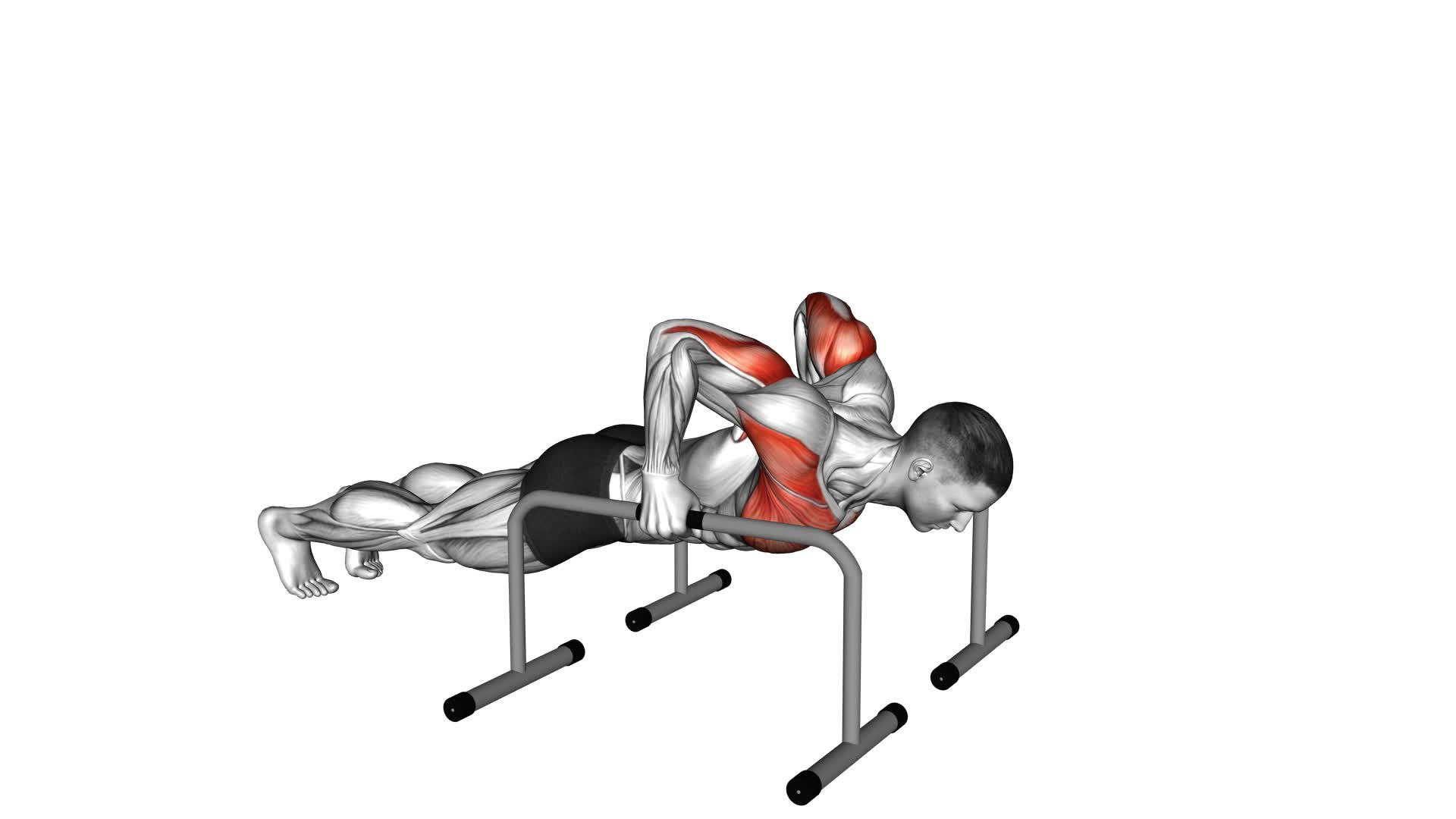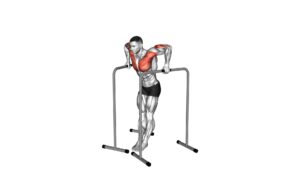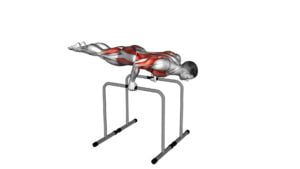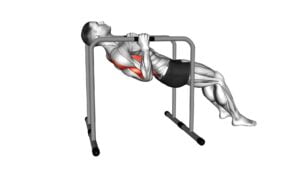Deep Push-up on Parallel Bars (male) – Video Exercise Guide & Tips

Looking to take your push-up game to the next level? Check out this video exercise guide for deep push-ups on parallel bars.
Watch This Exercise Video
In this guide, we'll show you the proper form, advanced variations, and common mistakes to avoid. Plus, we'll share tips on how to maximize your deep push-up workout.
Get ready to challenge yourself and achieve impressive results with this intense upper body exercise.
Let's get started!
Key Takeaways
- Deep push-ups on parallel bars can improve upper body strength.
- They target and develop the chest, shoulders, triceps, and core muscles.
- Deep push-ups on parallel bars enhance core stability and posture.
- There are advanced variations of deep push-ups on parallel bars to challenge yourself and increase the intensity of the workout.
Benefits of Deep Push-ups on Parallel Bars
Improve your upper body strength and core stability by incorporating deep push-ups on parallel bars.
Deep push-ups on parallel bars offer numerous benefits for your upper body and core muscles. By performing this exercise, you can effectively target and strengthen your chest, shoulders, triceps, and core muscles.
Deep push-ups on parallel bars specifically target your upper body, helping to improve your overall upper body strength. As you lower yourself down, your chest muscles are engaged, allowing you to build strength and definition in your pectoral muscles. Additionally, your shoulders and triceps are also activated, resulting in increased strength and muscle development in these areas.
Incorporating deep push-ups on parallel bars into your workout routine also helps to enhance your core stability. The parallel bars require you to engage your core muscles to maintain proper form and balance throughout the exercise. This helps to strengthen the muscles in your abdomen, lower back, and hips, improving your overall stability and posture.
Proper Form for Deep Push-ups on Parallel Bars
To perform deep push-ups on parallel bars with proper form, position yourself between the bars with your hands gripping the bars at shoulder-width apart. Make sure your body is straight and aligned from head to toe, with your core engaged. Lower yourself down slowly until your chest is just above the bars, keeping your elbows tucked in close to your body. Pause for a brief moment at the bottom before pushing yourself back up to the starting position.
When performing deep push-ups on parallel bars, there are some common errors to avoid. One mistake is allowing your shoulders to shrug up towards your ears, which can put unnecessary strain on your neck and upper back. Another common error is flaring your elbows out to the sides, which can increase the risk of shoulder injury. It's important to keep your elbows tucked in close to your body throughout the movement.
There are also variations of deep push-ups on parallel bars that you can try to target different muscle groups. One variation is the diamond push-up, where you place your hands close together in a diamond shape, focusing on your triceps. Another variation is the wide grip push-up, where you position your hands wider than shoulder-width apart to target your chest muscles more intensely.
Advanced Variations to Challenge Yourself
To challenge yourself further and continue building strength, incorporate advanced variations of deep push-ups on parallel bars.
These advanced modifications will help you take your workout to the next level and increase the difficulty of the exercise.
One advanced variation is the weighted deep push-up, where you add weight plates on your back or wear a weighted vest while performing the exercise. This will increase the resistance and make your muscles work harder.
Another modification is the plyometric deep push-up, where you explosively push off the bars and clap your hands together before landing back on the bars. This plyometric movement adds an element of power and explosiveness to the exercise.
You can also try doing deep push-ups with one arm on the bars and the other extended out to the side or behind your back, which challenges your core stability and upper body strength.
Incorporating these advanced variations into your routine will help you continue to progress and achieve your fitness goals.
Common Mistakes to Avoid
When performing deep push-ups on parallel bars, it's important to be aware of common mistakes that can hinder your progress and potentially lead to injury. By understanding and avoiding these mistakes, you can ensure that you're performing the exercise with proper technique and maximizing its benefits.
One common mistake to avoid is allowing your elbows to flare out to the sides. This not only puts unnecessary strain on your shoulders, but it also reduces the effectiveness of the exercise. Instead, keep your elbows tucked in close to your body, forming a 45-degree angle with your torso.
Another mistake to watch out for isn't maintaining a straight line from your head to your heels. Many people tend to let their hips sag or their back arch, which can lead to lower back pain and improper muscle activation. To fix this, engage your core muscles and squeeze your glutes to keep your body in a straight line throughout the movement.
Lastly, rushing through the exercise is a common mistake that can compromise your form and limit your progress. Take your time and perform each repetition with control, focusing on the mind-muscle connection and feeling the muscles work.
Tips for Maximizing Your Deep Push-up Workout
To maximize your deep push-up workout on parallel bars, focus on maintaining proper form and engaging the target muscles effectively. Here are four tips to help you maximize your gains and improve your strength:
- Keep your body straight: Maintain a straight line from your head to your heels throughout the exercise. Avoid sagging or arching your back, as this can lead to improper muscle activation and decreased effectiveness.
- Go deep: Aim to lower your body as close to the parallel bars as possible, while maintaining control and proper form. This will engage your chest, shoulders, and triceps more effectively, leading to greater gains in strength.
- Focus on the eccentric phase: Pay attention to the lowering phase of the push-up, also known as the eccentric phase. Lower yourself slowly and under control, as this can increase muscle damage and stimulate greater strength gains.
- Gradually increase difficulty: Once you have mastered the basic deep push-up, challenge yourself by adding weight or performing more advanced variations, such as using gymnastic rings. Gradually increasing the difficulty of the exercise will keep your muscles adapting and progressing.
Frequently Asked Questions
What Is the Recommended Number of Sets and Reps for Deep Push-Ups on Parallel Bars?
For deep push-ups on parallel bars, the recommended number of sets and reps can vary depending on your fitness level and goals. However, a general guideline is to start with 3 sets of 8-12 reps.
This will help strengthen your chest, shoulders, and triceps. If you experience wrist pain during deep push-ups, you can modify the exercise by performing them on your fists or using push-up handles to alleviate the pressure on your wrists.
Are Deep Push-Ups on Parallel Bars Suitable for Beginners?
Deep push-ups on parallel bars can be challenging for beginners. It's important to focus on proper breathing techniques to maintain control and avoid injury.
If you experience wrist pain, there are modifications you can make to alleviate the discomfort. Start by building strength and stability with regular push-ups before attempting deep push-ups on parallel bars.
Remember to listen to your body and progress at your own pace to avoid overexertion or strain.
Can Deep Push-Ups on Parallel Bars Help in Building Chest Muscles?
Deep push-ups on parallel bars are a great way to build chest muscles. Compared to regular push-ups, deep push-ups on parallel bars provide a greater range of motion, allowing for a deeper stretch and contraction of the chest muscles. This increased range of motion leads to greater muscle activation and ultimately helps in building chest muscles more effectively.
What Are the Possible Modifications for Individuals With Wrist Pain During Deep Push-Ups on Parallel Bars?
If you're experiencing wrist pain during deep push-ups on parallel bars, there are a few modifications you can try.
First, you can try using push-up handles or parallettes to decrease the strain on your wrists.
Another option is to perform push-ups on your fists instead of your palms. This can help to alleviate some of the pressure on your wrists.
Additionally, you can also try performing push-ups on an incline or with your knees on the ground to reduce the load on your wrists.
Are There Any Specific Breathing Techniques to Follow While Performing Deep Push-Ups on Parallel Bars?
When performing deep push-ups on parallel bars, it's important to focus on your breathing techniques. Deep breathing helps you maintain control and stability throughout the exercise.
Inhale as you lower your body down, and exhale as you push yourself back up. This rhythmic breathing can enhance your performance and provide a steady flow of oxygen to your muscles.
The benefits of deep push-ups on parallel bars include improved upper body strength and stability.
Conclusion
In conclusion, deep push-ups on parallel bars offer numerous benefits for building upper body strength and muscle definition.
By maintaining proper form and gradually progressing to advanced variations, you can challenge yourself and continue to improve.
Avoid common mistakes and follow the tips provided to maximize the effectiveness of your deep push-up workout.
Incorporate this exercise into your routine and watch as your strength and fitness levels increase.

Author
Years ago, the spark of my life’s passion ignited in my mind the moment I stepped into the local gym for the first time. The inaugural bead of perspiration, the initial endeavor, the very first surge of endorphins, and a sense of pride that washed over me post-workout marked the beginning of my deep-seated interest in strength sports, fitness, and sports nutrition. This very curiosity blossomed rapidly into a profound fascination, propelling me to earn a Master’s degree in Physical Education from the Academy of Physical Education in Krakow, followed by a Sports Manager diploma from the Jagiellonian University. My journey of growth led me to gain more specialized qualifications, such as being a certified personal trainer with a focus on sports dietetics, a lifeguard, and an instructor for wellness and corrective gymnastics. Theoretical knowledge paired seamlessly with practical experience, reinforcing my belief that the transformation of individuals under my guidance was also a reflection of my personal growth. This belief holds true even today. Each day, I strive to push the boundaries and explore new realms. These realms gently elevate me to greater heights. The unique combination of passion for my field and the continuous quest for growth fuels my drive to break new ground.







